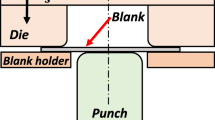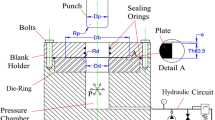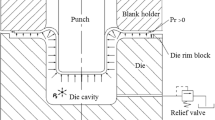Abstract
This study presents design, construction, and demonstration of a patented die system (UltraDRAW) used for deep drawing applications with utilization of ultrasonic vibrations. The developed system enables application of high-frequency vibrations onto the blank holder of die system in axial direction. Such design is considered to be effective in improving drawability of blank material, resulting in drawing of blanks with greater limiting drawing ratio (LDR) and lower forming load. For this purpose, an innovative ultrasonic horn with specific geometry, used directly as blank holder, was designed with steady-state harmonic response analyses using finite element method. To evaluate the performance of developed system, a series of cup drawing experiments using conventional and ultrasonically assisted die system were performed on cold-rolled low carbon steel sheets of DC01 and DC04 under dry and lubricated surface conditions. Compared to conventional drawing, UltraDRAW improved LDR and cup depth by 9.4% and 26.5% (for DC01) and 15.1% and 43.6% (for DC04) with reduction in forming load by 22.2% (for DC01) and 18.2% (for DC04).



















Similar content being viewed by others
References
Chang QF, Li DY, Peng YH, Zeng XQ (2007) Experimental and numerical study of warm deep drawing of AZ31 magnesium alloy sheet. Int J Mach Tools Manuf 47:436–443. https://doi.org/10.1016/j.ijmachtools.2006.06.013
Kim H, Sung JH, Sivakumar R, Altan T (2007) Evaluation of stamping lubricants using the deep drawing test. Int J Mach Tools Manuf 47:2120–2132. https://doi.org/10.1016/j.ijmachtools.2007.04.014
Ali S, Hinduja S, Atkinson J, Bolt P, Werkhoven R (2008) The effect of ultra-low frequency pulsations on tearing during deep drawing of cylindrical cups. Int J Mach Tools Manuf 48:558–564. https://doi.org/10.1016/j.ijmachtools.2007.06.013
Olguner S, Bozdana AT (2017) Influence of press ram pulsation on deep drawability of dual phase steel sheet. Acta Phys Pol A 132(3):742–745. https://doi.org/10.12693/APhysPolA.132.742
Lin J, Zhao SD, Zhang ZY, Wang ZW (2009) Deep drawing using a novel hydromechanical tooling. Int J Mach Tools Manuf 49:73–80. https://doi.org/10.1016/j.ijmachtools.2008.07.014
Irthiea I, Green G, Hashim S, Kriama A (2014) Experimental and numerical investigation on micro deep drawing process of stainless steel 304 foil using flexible tools. Int J Mach Tools Manuf 76:21–33. https://doi.org/10.1016/j.ijmachtools.2013.09.006
Fartashvand V, Abdullah A, Vanini SAS (2017) Investigation of Ti–6Al–4V alloy acoustic softening. Ultrason Sonochem 38:744–749. https://doi.org/10.1016/j.ultsonch.2016.07.007
Yao Z, Kim GY, Wanga Z, Faidley L, Zou Q, Mei D, Chen Z (2012) Acoustic softening and residual hardening in aluminum: Modeling and experiments. Int J Plasticity 39:75–87. https://doi.org/10.1016/j.ijplas.2012.06.003
Dauda Y, Lucas M, Huang Z (2007) Modelling the effects of superimposed ultrasonic vibrations on tension and compression tests of aluminium. J Mater Process Technol 186:179–190. https://doi.org/10.1016/j.jmatprotec.2006.12.032
Langenecker B (1966) Effects of ultrasound on deformation characteristics of metals. IEEE Trans Sonics Ultrasonics 13:1–8. https://doi.org/10.1109/T-SU.1966.29367
Hu J, Shimizu T, Yang M (2018) Investigation on ultrasonic volume effects: stress superposition, acoustic softening and dynamic impact. Ultrason Sonochem 48:240–248. https://doi.org/10.1016/j.ultsonch.2018.05.039
Lin J, Li J, Liu T, Zhu L, Chu X, Zhao G, Guan Y (2021) Evaluation of friction reduction and frictionless stress in ultrasonic vibration forming process. J Mater Process Technol 288:116881. https://doi.org/10.1016/j.jmatprotec.2020.116881
Wu L, Zhao C, Cao M, Han X (2021) Effect of ultrasonic and low frequency vibrations on friction coefficient at die radius in deep drawing process. J Manuf Processes 71:56–69. https://doi.org/10.1016/j.jmapro.2021.09.008
Smith AW (1977) An investigation of the deep drawing process with the application of ultrasonic oscillations. Ph.D. Thesis, The University of Aston, Birmingham, England
Wen T, Gao R, Chen X (2012) Influence of high frequency vibration on deep drawing process of AZ31 sheet at room temperature. J Shanghai Jiaotong Univ 17:456–460. https://doi.org/10.1007/s12204-012-1305-x
Lowe A, Hofmann A, Hauptmann M (2017) The use and application of ultrasonic vibrations in the 3D deformation of paper and cardboard. J Mater Process Technol 240:23–32. https://doi.org/10.1016/j.jmatprotec.2016.09.006
Lowe A, Hauptmann M, Majschak JP (2017) The effect of ultrasonic oscillation on the quality of 3D shapes during deep-drawing of paperboard. BioResources 12(4):7178–7194
Lowe A, Nikowski A, Hauptmann M (2020) Functional design of sonotrodes for deep-drawing of cardboard. BioResources 15(2):2763–2773
Sheykholeslami M, Cinquemani S, Mazdak S (2018) Numerical study of the of ultrasonic vibration in deep drawing process of circular sections with rubber die. In: SPIE active and passive smart structures and integrated systems XII, Denver-Colorado, USA
Yamazaki T, Hayakawa C, Kodama M, Jin M (2013) Deep drawing with ultrasonic vibration. J JSTP 54:47–51. https://doi.org/10.9773/sosei.54.47
Kim SW, Son YG, Lee YS (2014) FEA and experiment investigation on the friction reduction for ultrasonic vibration assisted deep drawing. Trans Mater Process 23:413–418. https://doi.org/10.5228/KSTP.2014.23.7.413
Huang YM, Wu YS, Huang JY (2014) The influence of ultrasonic vibration-assisted micro-deep drawing process. Int J Adv Manuf Technol 71:1455–1461. https://doi.org/10.1007/s00170-013-5553-1
Cao M, Li J, Yuan Y, Zhao C (2017) Flexible die drawing of magnesium alloy sheet by superimposing ultrasonic vibration. Trans Nonferrous Met Soc China 27:163–171. https://doi.org/10.1016/S1003-6326(17)60019-0
Zha C, Chen W (2019) Theories and experiments on effects of acoustic energy field in micro-square cup drawing. Int J Adv Manuf Technol 104:4791–4802. https://doi.org/10.1007/s00170-019-04338-1
Malekipour E, Heidary H, Majd NS, Mazdak S, Sharifi E (2020) Effect of resonant frequency variation on the ultrasonically assisted deep drawing process: numerical and experimental study. Int J Adv Manuf Technol 106:2243–2264. https://doi.org/10.1007/s00170-019-04545-w
Malekipour E, Sharifi E, Majd NS, Heidary H (2022) Observation on the behavior of ultrasonic micro-hammer and its effects on the deep drawing process: numerical simulation and experimental study. Ultrasonics 119:106566. https://doi.org/10.1016/j.ultras.2021.106566
Biddell DC, Sansome DH (1973) Deep drawing of cans with ultrasonic radial oscillations applied to the die. Ultrason Int Conf, London, England
Young MJR, Sansome DH (1975) An oscillatory deep-drawing analogue. In: Proceedings of fifteenth international machine tool design and research conference, Palgrave Macmillan Publishers Limited, London, 551–559
Biddell DC (1980) Ultrasonic deep-drawing and ironing with the aid of flat and profiled radial resonators. Acta Acust 45(1):14–24
Ashida Y, Aoyama H (2007) Press forming using ultrasonic vibration. J Mater Process Technol 187–188:118–122. https://doi.org/10.1016/j.jmatprotec.2006.11.174
Siddiq A, El Sayed T (2012) Ultrasonic assisted manufacturing processes: variational model and numerical simulations. Ultrasonics 52:521–529. https://doi.org/10.1016/j.ultras.2011.11.004
Jimma T, Kasuga Y, Iwaki N, Miyazawa O, Mori E, Ito K, Hatano H (1998) An application of ultrasonic vibration to the deep drawing process. J Mater Process Technol 80–81:406–412. https://doi.org/10.1016/S0924-0136(98)00195-2
Chu TH, Fuh KH, Yeh WC (2014) Modelling and analysis of deep drawing with utilization of vibrations and servo press using response surface methodology. Mater Res Innov 18:936–939. https://doi.org/10.1179/1432891714Z.000000000555
Bozdana AT, Olguner S (2018) An ultrasonically assisted die system for deep drawing process and its operating method (in Turkish). Turkish Patent and Trademark Office, Patent No: TR2018-15097
Olguner S, Bozdana AT (2020) Prediction of lankford coefficients for AA1050 and AA5754 aluminum sheets using uniaxial tensile tests and cup drawing experiments. In: Advances in design, simulation and manufacturing II, lecture notes in mechanical engineering, 438–446. https://doi.org/10.1007/978-3-030-22365-6_44
Olguner S, Bozdana AT (2023) Ultrasonically assisted deep drawing process: Two-stage finite element analysis and experimental verification. J Fac Eng Archit Gazi Univ 38(1):257–268
Acknowledgements
This work was financially granted by The Scientific and Technological Research Council of Türkiye (TUBITAK) with the project number of 315M300. The authors would like to express sincere thanks to TUBITAK for support. The die system developed within the scope of this study was registered by Turkish Patent and Trademark Office with the patent number of TR2018-15097.
Author information
Authors and Affiliations
Contributions
Methodology, investigation, validation, and manuscript draft preparation were performed by S. Olguner; conceptualization, supervision, resources, manuscript reviewing and editing were performed by A.T. Bozdana.
Corresponding author
Ethics declarations
Conflict of interest
The authors declare there is no conflicts of interest regarding the publication of this paper.
Additional information
Technical Editor: Lincoln Cardoso Brandao.
Publisher's Note
Springer Nature remains neutral with regard to jurisdictional claims in published maps and institutional affiliations.
Rights and permissions
Springer Nature or its licensor (e.g. a society or other partner) holds exclusive rights to this article under a publishing agreement with the author(s) or other rightsholder(s); author self-archiving of the accepted manuscript version of this article is solely governed by the terms of such publishing agreement and applicable law.
About this article
Cite this article
Olguner, S., Bozdana, A.T. Design, construction, and demonstration of a novel die system for deep drawing applications with utilization of ultrasonic vibrations. J Braz. Soc. Mech. Sci. Eng. 46, 124 (2024). https://doi.org/10.1007/s40430-024-04689-1
Received:
Accepted:
Published:
DOI: https://doi.org/10.1007/s40430-024-04689-1




